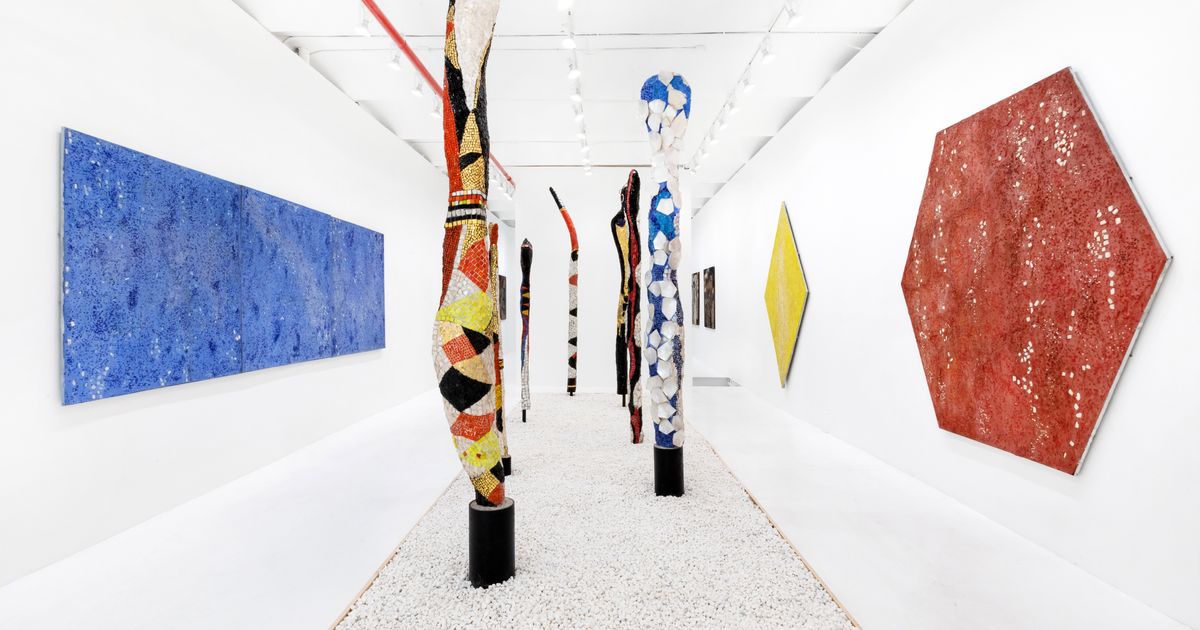ART WORLD NEWS
Jeanne Reynal, a woman Abstract Expressionist who ‘painted in stone’, gets overdue recognition
Installation view of Mosaic is Light: Work by Jeanne Reynal, 1940-1970 at Eric Firestone Gallery, New York
Courtesy Eric Firestone Gallery © 2021 Estate of Jeanne Reynal / Artists Rights Society (ARS), New York.Photo: Jenny Gorman
There is a tooth in one of Jeanne Reynal’s monochrome mosaics. You could almost miss it, embedded among hand-cut shards of glass, gemstone, and mother of pearl that the mid-20th century mosaicist used as tesserae. Yet the tooth is not the most unexpected thing about Reynal’s cement paintings and sculptures that fused Abstract Expressionism’s spontaneous gestures with mosaic—a historic medium that traditionally demands precise premeditation. “A central goal in her work was to make modern this ancient art form,” explains Jennifer Samet, research director at Eric Firestone Gallery, which recently started representing Reynal’s estate and where her works are now on view in the show Mosaic is Light. “One of the ways she was trying to do that was by applying [Abstract Expressionism’s] more intuitive, spontaneous approach to her process. That’s actually really hard to do with mosaics, because you only have a certain amount of time to work before the cement is going to dry.” Reynal would sometimes sketch a loose charcoal drawing onto her blocks of wet cement, but not always. She would line up all her precut stones, but otherwise made no preparations. “I like things to happen by accident,” Reynal once told the art historian Eleanor Munro. “The happy accident.” And unlike traditional mosaics, where geometric tesserae fill a frame with a recognisable image, her pigmented cement is just as visually important as the uneven stones—like patches of blank canvas peeping through the paint in a work by Jackson Pollock or Helen Frankenthaler. “She was very singular in her use of this medium,” Samet says, noting that Reynal’s other artist friends in New York were not using mosaic. “And the way that she was using it.”
Jeanne Reynal, Now is Winter (1950), smalti, marble and pigmented cement on board
Courtesy Eric Firestone Gallery © 2021 Estate of Jeanne Reynal / Artists Rights Society (ARS), New York
Her work was shown at some illustrious venues during her lifetime, including Betty Parsons Gallery and the San Francisco Museum of Modern Art, but she was never a big name and her work has rarely been shown since her death in 1983. Until now, Reynal’s estate was held by her extended family and kept in storage, with the weight and size of the unconventional works making them logistically difficult to move around. Some of her pieces are in museum collections and her mosaic at the Museum of Modern Art in New York has been shown twice in the past decade, but otherwise there have been few opportunities to see her work.Reynal’s legacy has also been stymied by the fact that she is often a footnote in the biographies of better-known artists in her circle, either as a friend or a patron. Samet, in fact, first encountered the mosaicist’s name when researching sculptor Isamu Noguchi and the painter Arshile Gorky. Reynal came from a wealthy New York family, and when her estranged parents died in 1940, they left her a significant inheritance that allowed her both to support herself and build a collection that included Willem de Kooning, Mark Rothko, Alberto Giacometti, Dorothea Tanning, Jackson Pollock, Alexander Calder, and Kay Sage, among others. Painter Elaine de Kooning said of Reynal that she was “a wonderful artist who was much better known as a collector.”The Eric Firestone Gallery, which assumed representation of Reynal’s estate in early September, now hopes to make her known as an artist in her own right, one whose innovations are still underappreciated. “They really do run counter to our expectations of the medium,” Samet says of Reynal’s freeform sculptures, totems, and what the artist dubbed “paintings in stone”. “Her work fell between the media, it wasn’t easily defined or categorised.”
Source link













